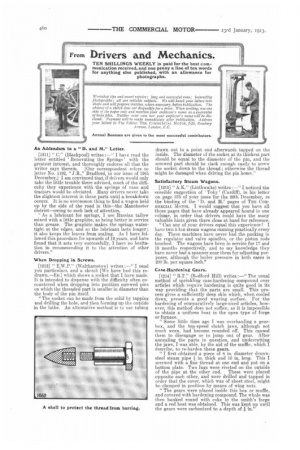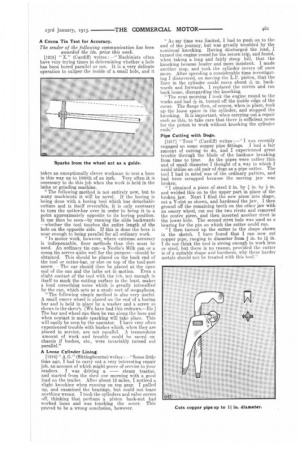Drivers and Mechanics.
Page 20

Page 21

If you've noticed an error in this article please click here to report it so we can fix it.
TEN SHILLINGS WEEKLY is paid for the hest communication received, and one penny a line of ten words for anything else published, with an allowance for photographs.
An Addendum to a "D. and M." Letter.
[1211] " C." (Blackpool) writes :—'' I have read the letter entitled Renovating the Springs' with the greatest interest, and thoroughly endorse all that the writer says therein. [Our correspondent refers to letter No. 1192, "J.B.," Bradford, in our issue of 19th December.] I am convinced that, if drivers would only take the little trouble there advised, much of the difficulty they experience with the springs of vans and tractors would be obviated. Many drivers never take the slightest interest in these parts until a breakdown occurs, It is no uncommon thing to find a wagon held lip by the side of the road in this—the Manchester district—owing to such lack of attention.
"As a lubricant for springs, I use Russian tallow mixed with a little graphite, as being better in service than grease. The graphite makes the springs watertight at the edges, and so the lubrieant lasts longer ; it also keeps the leaves from scaling. As I have followed this procedure for upwards of 12 years, and have found that it acts very successfully. I have no hesitation in recommending it to the attention of other drivers,"
When Dropping in Screws.
[1212] " E.W.P." (Walthamstow) writes :—" I send you particulars, and a sketch [We have had this redrawn.—.En.] which which shows a socket that I have made. It is intended to dispense with the difficulty often encountered when dropping into position screwed pins on which the threaded part is smaller in diameter than the body of the pin itself.
" The socket can be made from the solid by tapping and drilling the hole, and then forming up the outside in the lathe. An alternative method is to use tubing
drawn out to a point and afterwards tapped on the inside. The diameter of the socket at its thickest part should be equal to the diameter of the pin, and the screwed part should be slack enough easily to screw the socket down to the thread ; otherwise the thread might be damaged when driving the pin home," Satisfactory Steam Wagons.
[1213] "A.K." (Linthwaite) writes : —" I noticed the &sensible suggestion of ' Toby ' (Cardiff), in his letter on page 275 of your issue for the 26th December, re the binding of the 'D. and M2 pages of THE COMMERCIAL MOTOR. I would suggest that you have all those pages that have already appeared bound in one volume. in order that drivers could have the many valuable hints given there close at hand for reference.
" Can any of your drivers equal this experience ? I have two 5.ton steam wagons running practically every day. These machines have never had the packing in the regulator and valve spindles, or the piston rods touched. The wagons have been in service for 17 and 15 months respectively, and to my knowledge they have never had a spanner near them for adjusting purposes, although the boiler pressure in both awes is 200 lb. per square mob."
Ca se-Hardening Gears.
[12141 " R.T." (Bedford Hill) writes :—" The usual method of sprinkling case-hardening compound over articles which require hardening is quite good in its way providing that the parts are small. This process gives a suffieiently deep skin which, when cooled down, presents a good wearing surface. For the hardening of comparatively large-sized articles, however, this method does not suffice, as it is impossible to obtain a uniform heat in the open type of forge or furnace.
"Some little time ago I was overhauling a gearbox, and the top-speed clutch jaws, although not much worn, had become rounded off. This caused them to disengage or to jump out of gear. After annealing the parts in question, and undercutting the jaws, I was able, by the aid of the muffle, which I describe, to re-harden these gears.
" I first obtained a piece of 8 in. diameter drawnsteel steam pipe in. thick and 10 in. long. This I screwed with a fine thread at one end and put on a bottom plate. Two lugs were riveted on the outside of the pipe at the other end. These were placed opposite each other, and were drilled and tapped in order that the cover, which was of sheet steel, might be clamped in position by means of wing nuts.
"The gears were placed inside this box or muffle, and covered with hardening compound. The whole was then banked round with coke in the smith's forge and a red heat was obtained. This was kept up until the gears were carbonized to a depth of A Cocoa Tin Test for Accuracy.
The sender of the following communication has been awarded the 108. prize this week.
[1215] " X." (Cardiff) writes : —" Machinists often have very trying times in determining whether a hole has been bored parallel or not. It is a very delicate operation to caliper the inside of a small hole, and it
takes an exceptionally clever workman to test a bore in this way up to 1000th of an inch. Very often it is necessary to do this job when the work is held in the lathe or grinding machine. "The following method is not entirely new, but to many machinists it will be novel. If the boring is being done with a boring tool which has detachable cutters and is itself reversible, it is only necessary to turn the cutter-bar over in order to bring it to a point approximately opposite to its boring position. It can then be seen—by running the slide backwards —whether the tool touches the entire length of the hole on the opposite side. If this is done the bore is near enough to being parallel for all ordinary work. "In motor work, however, where extreme accuracy is indispensable, finer methods than this must be used. An ordinary tin can—a Nestle's Milk can or a cocoa tin serves quite well for the purpose—should be obtained. This should be placed on the back end of the tool or cutter-bar, or else on top of the tool-post screw. The ear should then be placed at the open end of the can and the lathe set in motion. Even a slight contact of the tool with the job, not enough in itself to mark the cutting surface in the least, makes a loud screeching noise which is greatly intensified by the can, which acts as a crude sort of megaphone. "The following simple method is also very useful. A small emery wheel is placed on the end of a boring bar and is held in place by a washer and a screw as shown in the sketch, [We have had this redrawn.—En.] The bar and wheel can then be run along the bore and when contact is made sparking will take place. This will easily be seen by the operator. I have very often experienced trouble with bushes which, when they are placed in service, are not parallel. A tremendous amount of work and trouble could be saved on chassis if bushes, etc., were invariably turned out parallel" A Loose Cylinder Lining.
[1216] " A.G." (Sittingbourne) writes : —"Some little time ago, I had to carry out a very interesting repair job. an account of which might prove of service to your readers. T was driving a steam tractor, and started from, the shed one morning with a good load on the trailer. After about 12 miles, I noticed a. slight knocking when running on top gear. I pulled up, and examined the bearings, but could not trace anything wrong. T took the cylinders and valve covers off, thinking that perhaps a piston back-nut had worked loose and was touching the cover. This proved to be a wrong conclusion, however.
"As my time was limited, I had to push on to the end of the journey, but was greatly troubled by the continual knocking. Having discharged the load, I turned the engine round for the return trip, and found, when taking a long and fairly steep hill, that the knocking became louder and more insistent. I made another stop, and took the cylinder covers off once more. After spending a considerable time investigating I discovered, on moving the L.P. piston, that the liner in the cylinder could move about -eT in. backwards and forwards. I replaced the covers and ran back home, disregarding the knocking. "The next morning I took the engine round to the works and had -Ain. turned off the inside edge of the cover. The flange then, of course, when in place, took up the loose space in the cylinder, and stopped the knocking. It is important, when carrying out a repair such as this, to take care that there is sufficient room for the piston to work without knocking the cylinder ends."
Pipe Cutting with Dogs.
[1217] " Tony " (Cardiff) writes :—" I was recently engaged on some copper pipe fittings. I had a fair amount of cutting to do, and I experienced great trouble through the blade of the hacksaw breaking from time to time. As the pipes were rather thin and of small diameter I thought of a way in which I could utilize an old pair of dogs as a pipe cutter. The tool I had in mind was of the ordinary pattern, and had been scrapped because the moving jaw was broken.
"I obtained a piece of steel 2 in. by in. by in. and welded this on to the upper part in place of the broken jaw. Next I filed the new piece into shape, cut a V-slot as shown, and hardened the jaw. I then ground off the remaining teeth on the other jaw with an emery wheel, cut out the two rivets and removed the centre piece, and then inserted another rivet in the lower hole_ The second rivet hole was used as 11 bearing for the pin on which the cutter could run. "I then turned up the cutter to the shape shown in the sketch. I have found that I can now cut copper pipe, ranging in diameter from in. to I do not think the tool is strong enough to work iron or steel, but there is no reason, provided the cutter is of a suitable shape and hardness, why these harder metals should not be treated with this tool."






















